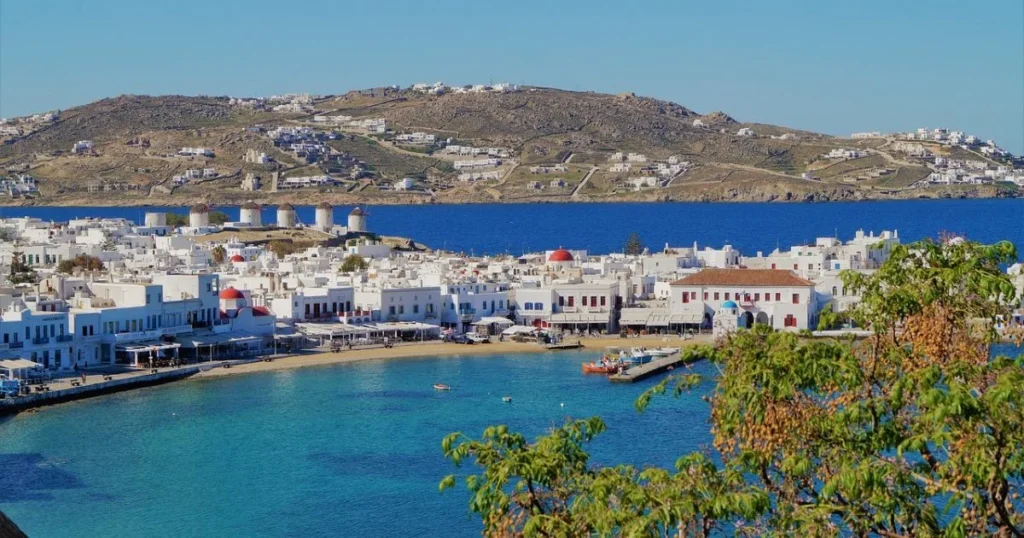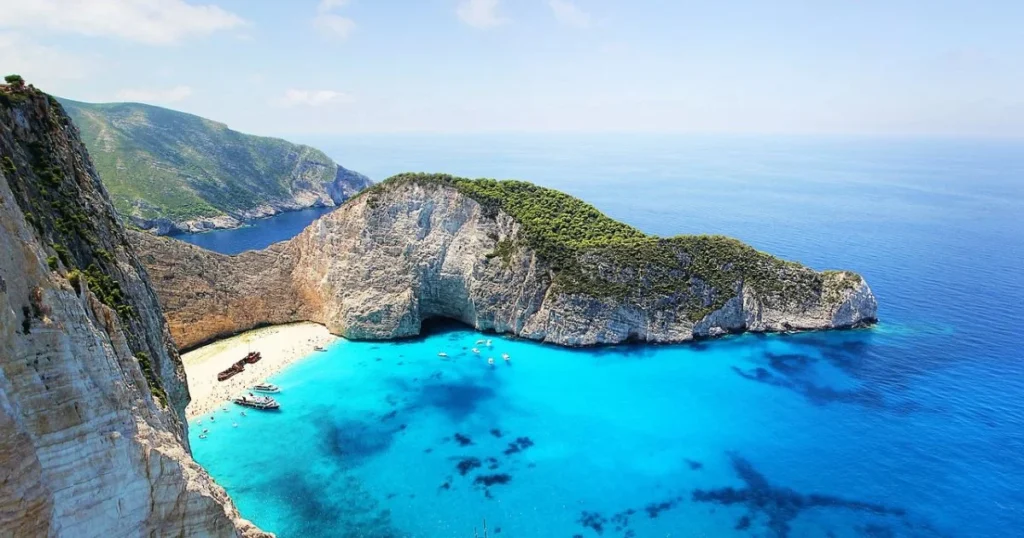when is the best time to travel to greece: Imagine stepping onto Greece‘s sun-soaked shores, surrounded by ancient history, dazzling blue waters, and vibrant culture. You’re walking through quiet coastal villages, exploring breathtaking ruins under the perfect sunlight, all without the hustle of crowded tourist spots. This is the Greece travelers dream of—a place where magic, mystery, and serenity collide. But timing is everything. This article reveals the best months to experience Greece’s most charming side, with mild weather and a sense of exclusivity that only off-peak travel can provide.
Table of Contents
Why Choose Greece for Your Next Adventure?
Overview of Greece’s Unique Appeal
Greece offers a blend of rich history, captivating natural beauty, and a Mediterranean climate that makes it a paradise for travelers. From the iconic Parthenon in Athens to the stunning island sunsets of Santorini and the rugged landscapes of Crete, Greece is an adventurer’s paradise. Here, you’ll find sunlit beaches, ancient landmarks, and an unforgettable atmosphere.
Why Timing Matters
Traveling to Greece at the right time can make a big difference. Each season showcases a different side of Greece’s allure, and choosing off-peak months allows for a quieter, more affordable experience. You’ll enjoy Greece’s splendor with fewer crowds, comfortable weather, and access to authentic experiences. So, let’s dive into the ideal times to visit based on season.
Seasonal Overview of Greece’s Climate and Tourist Trends
Winter (December to February)
A Quieter Side of Greece in Winter
Winter brings a different pace to Greece. With cooler temperatures, fewer tourists, and significantly lower prices, it’s an excellent season for travelers interested in cultural explorations. Athens and other historical sites are less crowded, making this season ideal for experiencing Greece’s history in a peaceful setting. Although beach days are rare, Greece’s mild winters are comfortable for sightseeing and soaking in the local culture.
Spring (March to May)
A Blossoming Season with Mild Weather
Spring is a magical time in Greece, with mild temperatures, blooming flowers, and rejuvenated landscapes. You’ll enjoy fewer crowds compared to summer, making it perfect for nature lovers and those eager to explore Greece’s stunning scenery. Hiking trails in areas like Mount Olympus and the Peloponnese region are a highlight, showcasing Greece’s natural beauty in full bloom.
Summer (June to August)
The Peak of Tourist Season with Warm Weather
Summer is Greece’s peak season, characterized by hot weather and bustling tourist activity. Beach lovers flock to islands like Mykonos and Santorini for sun and sea adventures. While this season offers a lively atmosphere, it also comes with crowded sites and higher prices. If you enjoy vibrant energy and festive vibes, summer might be your season. However, prepare for busier days at popular destinations.
Fall (September to November)
The Sweet Spot for Pleasant Weather and Fewer Crowds
Fall is a dream come true for travelers looking for a mix of mild weather and reduced crowds. In September, the warmth lingers, and the Aegean Sea is still warm enough for swimming. This season is ideal for those who want to explore cultural sites, enjoy outdoor activities, or even go island hopping without the summer rush.

Best Months to Visit Greece for Perfect Weather and Fewer Crowds
April and May: The Ideal Time for Spring Travelers
When you think of the perfect Greek getaway, April and May offer an idyllic escape, especially for those seeking a balance of pleasant weather and fewer tourists. Spring is in full swing during these months, transforming the landscape with a riot of colorful flowers and fresh greenery.
Why April and May? During April and May, Greece’s natural beauty is on full display. With mild temperatures, you won’t have to worry about the intense summer heat. In April, temperatures typically range from 15°C to 20°C (59°F to 68°F), while in May, they rise to between 20°C and 25°C (68°F to 77°F).
The days are long, allowing for plenty of daylight hours to explore, but they’re not as scorching as the summer months. This makes it an ideal time to engage in outdoor activities like hiking, exploring ruins, or walking through charming villages. For instance, places like Mount Olympus or the Peloponnese region become lush with new life, and the famous Santorini and Mykonos islands are far less crowded, allowing you to fully experience their beauty without the summer rush.
Fewer Crowds, Lower Prices What makes April and May especially appealing is the opportunity to experience Greece’s treasures without the hordes of summer tourists. Popular destinations like Athens, Crete, and the Cycladic Islands tend to be quieter during this time, which means you can enjoy historical sites such as the Acropolis or Knossos Palace without the crowds. Additionally, accommodation rates are lower, and you can often find discounts on tours and activities. This budget-friendly aspect makes these months perfect for travelers seeking an authentic Greek experience without overspending.
Ideal for Outdoor Exploration Spring is a fantastic time to connect with nature. The landscape is verdant, with wildflowers blooming, creating a picturesque backdrop for hiking, photography, or leisurely strolls. For example, you can hike in Crete’s Samaria Gorge, enjoy peaceful walks along the Naxos coast, or bike through Athens’ lush parks. The temperate weather also means it’s perfect for those who enjoy cultural exploration—whether that’s visiting ancient ruins or experiencing local festivals (without the overwhelming crowds).

September and October: The Ultimate Fall Experience in Greece
As the intense heat of summer fades away, September and October emerge as the golden months for experiencing Greece at its most serene. The weather remains comfortably warm, the sea stays inviting, and the bustling summer crowds have started to dissipate. These months are a true sweet spot for travelers who prefer a laid-back atmosphere while still enjoying the country’s highlights.
Why September and October? September and October bring moderate temperatures, perfect for enjoying the Mediterranean climate. September still boasts summer-like warmth, with average temperatures ranging from 25°C to 30°C (77°F to 86°F), which means the sea is warm enough for swimming, while October cools down slightly to a comfortable 20°C to 25°C (68°F to 77°F). The summer heat no longer feels overwhelming, and you can comfortably enjoy outdoor activities, whether that’s lounging on a beach, visiting archaeological sites, or hiking through scenic landscapes.
Less Crowded, More Tranquil In these months, most Greek islands and tourist destinations have shed their summer bustle. If you prefer a more peaceful experience, Santorini, Mykonos, and Rhodes become much quieter, and the popular cities like Athens are far more relaxed. The absence of the high-season crowds means that the best spots—such as Oia’s sunset view in Santorini or Mykonos’ windmills—are no longer packed, allowing you to take in the beauty at your own pace.
A Deep Dive into Culture and Heritage In addition to the calming atmosphere, September and October are prime months for cultural exploration. Many of Greece’s historical sites, such as the Ancient Agora in Athens, become even more enjoyable as the oppressive summer crowds have dispersed. With fewer tourists, you can take your time to absorb the history and significance of each place. Moreover, the fall months allow you to experience the island lifestyle authentically, with local markets and leisurely boat tours available without the usual congestion.
The Ideal Time for Water Activities For beach lovers, September and October offer perfect conditions. The water temperatures stay at around 24°C to 26°C (75°F to 79°F), which is ideal for swimming, diving, and other water-based activities. The weather is still warm enough for lounging on the beach, but you’ll have much more space to spread out and enjoy the serenity of the Greek coastlines.
Data and Sources to Include:
- Weather Data: Average temperature and rainfall data from reputable sources like the Greek National Meteorological Service or Weather2Travel for more accurate details on temperatures and precipitation levels in April-May and September-October.
- Anecdotal Evidence: Insights from seasoned travelers or travel bloggers who have visited Greece during these months, highlighting their personal experiences with fewer crowds, better pricing, and enjoyable weather.
Example Quote from Traveler: “Visiting Athens in April was a dream—mild temperatures meant we could explore the Acropolis without the scorching heat or long lines. And in October, the sea was still warm enough for swimming, but we had the beach almost to ourselves.” — Maria, Travel Blogger

Island-Specific Recommendations for Ideal Travel Times
Best Months for Santorini, Mykonos, and Crete
When it comes to visiting some of Greece’s most iconic islands, timing your trip is crucial for a memorable experience. Each island offers its own unique charm, and understanding the best months to visit can help you make the most of your trip, avoiding the crowds while enjoying ideal weather.
Santorini: is most enjoyable when visited from late April to May or between September and October
Santorini is one of the most picturesque destinations in the world, known for its stunning cliffside views and iconic whitewashed buildings. For a more serene experience on the island, consider visiting between late April and May, or from September to October, when the crowds are lighter. During these months, the weather is mild, perfect for sightseeing and photography, and the island’s beauty is enhanced by the lack of overwhelming tourist traffic.
- Ideal Timing: Late April to May and September to October
- Why These Months Are Best:
- Moderate temperatures make walking through the island’s narrow streets and exploring the towns of Fira and Oia comfortable.
- The stunning views of the iconic blue domes are most enjoyable when you can take in their beauty without the summer crowds.
- Perfect for capturing those Instagram-worthy shots, as the light is softer and more flattering.
- Recommended Activities:
- Photography Tours: Capture the stunning sunset views and iconic architecture.
- Sightseeing: Explore the ancient ruins of Akrotiri or visit the charming villages.
- Scenic Viewpoints: Discover peaceful spots with breathtaking views of the island’s landscapes, ideal for photography and relaxation.
Mykonos: Best Visited in May or Late September
Mykonos is renowned for its vibrant energy, cosmopolitan charm, and stunning beaches. If you want to enjoy Mykonos at its best, visit in May or late September. The weather is warm enough for beach days, but without the overwhelming crowds that flood the island during peak summer months.
- Ideal Timing: May and late September
- Why These Months Are Best:
- The temperatures are warm but not excessively hot, perfect for enjoying the beaches and coastal activities.
- The island is quieter, giving you the opportunity to relax and explore the island without battling the summer crowds.
- Recommended Activities:
- Explore Local Markets: Mykonos has beautiful boutique stores and vibrant markets to browse.
- Relax on Beaches: Enjoy the pristine beaches with fewer tourists around.
- Food Tours: Discover the island’s culinary delights, from fresh seafood to local specialties.
Crete: Ideal in Spring and Fall
Crete is the largest Greek island, offering a diverse landscape that ranges from pristine beaches to rugged mountains. The island truly shines in the spring and fall months, when the weather is mild, and you can enjoy outdoor activities in comfort without the summer heat or the crowds.
- Ideal Timing: Spring (March to May) and Fall (September to November)
- Why These Months Are Best:
- The mild weather makes it ideal for outdoor exploration, whether you’re hiking in the Samaria Gorge or exploring the charming towns.
- The summer rush is over, and you can explore the island’s archaeological wonders like the Palace of Knossos without crowds.
- The fall season, in particular, offers warm weather ideal for swimming but without the peak-season hustle.
- Recommended Activities:
- Hike Scenic Trails: Explore Crete’s vast and varied landscapes, from its stunning coastlines to the lush hills.
- Visit Archaeological Sites: Don’t miss the opportunity to explore ancient sites like the Palace of Knossos.
- Immerse Yourself in Village Life: Visit traditional villages and enjoy the island’s authentic culture.
Final Thoughts: Each of these islands offers something unique, and by planning your visit during these recommended months, you can enjoy Greece’s beauty while avoiding the large crowds that can detract from the experience. Whether you’re looking for peaceful sightseeing in Santorini, beach relaxation in Mykonos, or outdoor adventures in Crete, choosing the right time to visit will ensure an unforgettable experience.

How to Enjoy Greece with Fewer Crowds
Travel Strategies for Off-Peak Times
If you’re looking to experience Greece without the usual crowds, timing is everything. A great way to avoid the hustle and bustle of tourist hotspots is by visiting popular attractions during the early morning or late evening. These times are typically much quieter, allowing you to appreciate the beauty of iconic landmarks without having to share the space with large crowds. The cool mornings and evenings also offer a more relaxed atmosphere, perfect for taking in the sights at your own pace.
Another way to experience Greece off the beaten path is by utilizing local guides. While major tourist destinations are well-known and crowded, there are many lesser-known spots that hold just as much charm, if not more. Local guides can take you to hidden gems that aren’t featured on typical tourist itineraries, allowing you to experience the true essence of Greece. Whether it’s an undiscovered village, a secluded beach, or a small historical site, these areas offer a unique and peaceful side of Greece that often goes unnoticed by mass tourism.
Consider exploring smaller, less touristy islands or towns where life moves at a slower pace. Many of these places, especially in the off-season, offer a more authentic experience and give you the opportunity to interact with locals in a way that larger cities don’t allow. These quieter locations will let you appreciate the beauty of Greece without the constant influx of tourists.
Booking Tips for Lower Rates
To ensure you get the best rates on flights and accommodations, it’s important to book your trip well in advance—ideally a few months before your planned departure. Booking early gives you a greater chance of securing lower prices, especially if you’re traveling during a less popular season. Traveling during the shoulder months (spring or fall) can also provide a balance between good weather and lower prices.
When booking accommodations, be sure to consider staying outside the major cities or popular tourist areas. Smaller towns or villages often offer more affordable lodging options without sacrificing comfort or authenticity. These areas tend to have fewer tourists, allowing for a more relaxed and genuine Greek experience.
It’s also wise to avoid traveling during peak holiday periods, such as the height of summer or around major festivals. If you still want to experience the local culture, plan your visit during off-peak times, when the streets are quieter and the atmosphere is more laid-back. If you’re looking to explore Greece’s culture, historical sites, or natural beauty, you can often enjoy a much richer experience when the crowds are thinner, and the rates are more reasonable.
In addition, if you’re flexible with your travel dates, consider booking flights and accommodations mid-week, when demand is typically lower. This small adjustment could lead to significant savings and a more relaxed trip overall. By making thoughtful decisions about when and where you book your trip, you can enjoy the wonders of Greece while keeping costs down and avoiding the overwhelming crowds.
Pros and Cons of Visiting Greece in Each Season
Weighing the Benefits and Drawbacks
Every season in Greece offers unique benefits. While summer provides perfect beach days, it also brings higher prices and more crowds. Spring and fall offer milder weather and fewer tourists, while winter is excellent for cultural exploration. Decide based on what you prioritize—whether it’s beach lounging, sightseeing, or tranquility. Here’s a quick breakdown:
- Winter: Affordable, quiet, best for city and cultural tours.
- Spring: Great weather, beautiful landscapes, fewer crowds.
- Summer: Lively, ideal for beach lovers, but crowded.
- Fall: Warm seas, relaxed vibe, perfect for both beaches and sightseeing.
FAQ Section: When is the Best Time to Travel to Greece? Frequently Asked Questions
- “Is September a great time to travel to Greece?”
Absolutely! September is one of the best months with warm weather and fewer tourists, making it ideal for beach activities and cultural exploration. - “What is the top Greek island to explore during the spring?”
Crete and Santorini offer stunning spring landscapes and mild weather, perfect for outdoor adventures. - “How crowded is Greece in October?”
October sees a noticeable decline in crowds, especially compared to summer, allowing for a more serene experience at popular sites.
Conclusion: Plan Your Dream Greek Getaway with the Perfect Timing
Timing your trip to Greece can turn an amazing experience into an unforgettable one. With the right balance of weather, crowd levels, and activities, you can discover the best of what Greece offers. Whether you’re drawn to the sunny shores of Mykonos, the vibrant culture of Athens, or the historic sites of Crete, there’s an ideal season for you. So start planning your dream Greek escape, and book your trip during the recommended months for the experience of a lifetime.

